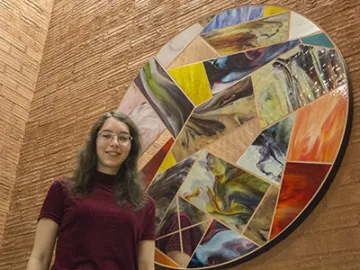Another Wavelength: Jasmine Sears

As we all gear up for another fantastic fall semester, the College of Optical Sciences gladly welcomes back its stellar students. This month on Another Wavelength, we meet Jasmine Sears, a fifth-year Ph.D. candidate in Galina Khitrova's lab.
Originally from Portland, Oregon, Jasmine received her undergraduate degree from the California Institute of Technology. She has been active in the OSC community, serving as a SOCk officer and GPSC representative. She's also made a splash on the UA entrepreneurship scene – this spring, she was a finalist in the inaugural Grad Slam pitch contest, and her startup company, Edible Optics, was just announced as a member of the newest Arizona Center for Innovation cohort.
What brought you to optics?
I studied applied physics in undergrad and took an Intro to Optics lecture/lab class my sophomore year. It was awesome, and led me to work in an optofluidics lab doing fun stuff like replicating fly eyes (their lenses have weird nanostructures that make their eyes naturally antireflective!).

Who would you call your science hero?
Rachel Carson. She wrote "Silent Spring," which presented the environmental impacts of pesticide overuse in a way that nonscientists could actually relate to, and which prompted public action where scientific studies had been ignored. Before that, she used her marine biology background to write some popular (and scientifically accurate) books about the ocean. She was apparently fantastic at taking a dry topic and turning it into a captivating story, and she managed to convert basic research into tangible social change.
Describe your research in 20 words or fewer.
I look at tiny slices of materials to predict and understand their behavior.
Describe your research in 200 words or fewer.
My group grows some really interesting structures using molecular beam epitaxy, which involves a big vacuum chamber and extremely hot reservoirs of metals. By precisely controlling which metals are allowed to escape into the chamber, we can grow samples layer by atomic layer. One unique structure out of our lab is a self-assembled indium nanoantenna – we can grow these tiny indium islands all over a substrate, such as a quantum well or a pure semiconductor. These islands would ideally be pure indium, but we couldn't just make that assumption; instead, I took minuscule cross-sections of these already-tiny islands, and then used transmission electron microscopy and energy-dispersive spectroscopy to map out the exact distribution of elements within the islands.

This distribution seems to depend pretty heavily on the MBE parameters, which helps us understand which applications a given set of islands might be suitable for. For example, some of our islands are pure enough to show superconducting behavior, but the one in this picture has too much gallium and arsenic mixed in with the indium, so we don't expect it to behave much differently from a standard nanoantenna.
Name three four* neat facts about you.
-
I make fancy chocolates! Key lime truffles, pumpkin spice truffles, chocolate Companion Cubes (from the video game Portal) ...Image

- This summer, I drove 1,900 miles solo in one 31-hour trip. That's an average of 61 mph including stops.
- I have fallen asleep inside of a ceiling.
- I've started a company! Edible Optics aims to provide an engaging, hands-on introduction to optical engineering using edible lenses. We're developing a build-your-own telescope kit that will guide kids (and their parents) through the steps and science behind casting lenses, assembling a telescope and exploring their surroundings. Since candy lenses are cheaper and safer than glass or plastic lenses, younger kids can play with the assembled telescopes unsupervised and older kids can easily experiment with modifications to the basic design. We already have a working prototype, so our next step is to playtest the kit with actual kids and see what tweaks need to be made. We've also developed a lens lollipop lesson plan through collaboration with a local elementary school teacher, and we're hoping to eventually develop kits geared specifically to classrooms.
[Editor's note: We asked Jasmine to tell us more about Edible Optics, so this month offers a bonus neat fact.]
